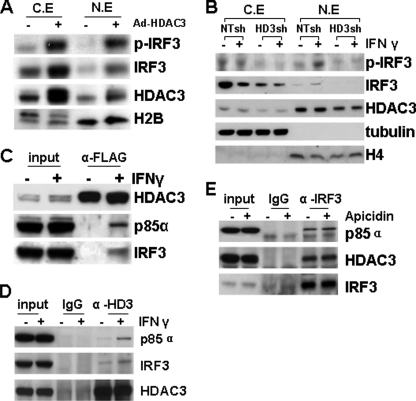FIGURE 6.
IFN-γ enhances the HDAC3-p85α-IRF3 complex formation. A, overexpression of HDAC3 induced IRF3 nuclear translocation. HUVECs were infected with 10 m.o.i. Ad-HDAC3 virus for 48 h, followed by cellular fraction assay. Ad-null virus was included as control. C.E, cytosolic extract; N.E, nuclear extract. B, HDAC3 knockdown ablated IFN-γ-induced IRF3 nuclear translocation. HUVECs were infected with NTsh or HD3sh for 72 h, and then treated with 10 ng/ml IFN-γ for 4 h, followed by cellular fraction assay. Anti-tubulin and histone H4 antibodies were included to identify cytosol and nuclear fractions. C, IFN-γ induced the formation of the HDAC3-p85α-IRF3 complex. HUVECs were infected with Ad-FLAG-HDAC3 virus at 10 m.o.i. and 48 h later treated with 10 ng/ml IFN-γ for 4 h, followed by immunoprecipitation assay with anti-FLAG antibody. 50 μg of lysate was included as input. D, IFN-γ enhanced endogenous HDAC3 association with p85α-IRF3. HUVECs were treated with 10 ng/ml IFN-γ for 4 h, followed by immunoprecipitation assay with anti-HDAC3 antibody. E, HDAC3 activity is unnecessary for HDAC3-p85α-IRF3 complex formation. HUVECs were treated with 10 ng/ml IFN-γ for 4 h in the presence or absence of apicidin, followed by immunoprecipitation with anti-IRF3 antibody. Dimethyl sulfoxide was included as vehicle control.

